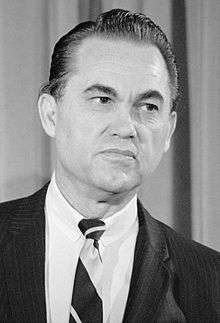1972 Democratic Party presidential primaries
The 1972 Democratic presidential primaries were the selection process by which voters of the Democratic Party chose its nominee for President of the United States in the 1972 U.S. presidential election. Senator George McGovern of South Dakota was selected as the nominee through a series of primary elections, caucuses, and state party conventions, culminating in the 1972 Democratic National Convention held from July 10 to July 13, 1972, in Miami, Florida.
| |||||||||||||||||||||||||||||||||||||||||||||||
| |||||||||||||||||||||||||||||||||||||||||||||||
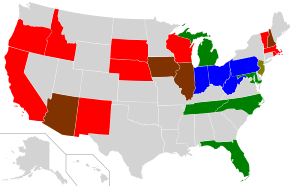 First place finishes by popular vote Red denotes a state won by George McGovern. Blue denotes a state won by Hubert Humphrey Green denotes a state won by George Wallace. Brown denotes a state won by Edmund Muskie. Gold denotes a state won by Shirley Chisholm. | |||||||||||||||||||||||||||||||||||||||||||||||
| |||||||||||||||||||||||||||||||||||||||||||||||
Background
As 1972 approached, President Richard Nixon faced uncertain re-election prospects. Nixon had been elected in 1968 on a platform to end American involvement in Vietnam, but his strategy of gradually handing over operational control of the conflict to the South Vietnamese military (Vietnamization) was proceeding more slowly than planned. Nixon had in fact widened the conflict by invading Cambodia in 1970, a move that ignited criticism in the press and Congress and widespread disorder on college campuses. The Paris Peace Talks had bogged down, dimming hopes for a negotiated settlement to the war. On the domestic front, a sharp recession in 1969 had shaken investor confidence and Nixon's plan to control inflation with wage and price controls had failed to meet its objective. The administration's attempt to steer a middle course on issues of busing and affirmative action had displeased liberals and conservatives alike. Republican losses in the 1970 midterm elections further weakened the party's congressional and gubernatorial position.
As a result, a large field of Democratic challengers emerged. The establishment favorite for the Democratic nomination was Ed Muskie,[1] the moderate who acquitted himself well as the 1968 Democratic vice-presidential candidate. In August 1971 Harris polling amid a growing economic crisis, Muskie came out on top of incumbent Nixon if the election had been held that day.[1]
Shirley Chisholm announced she would run and became the first black person ever to run for president on a major party ticket and the first woman to run for the Democratic presidential nomination.[2]
Primary campaign
Prior to the New Hampshire primary, the "Canuck Letter" was published in the Manchester Union-Leader. The letter, later revealed to have been a forgery produced as part of the "dirty tricks" campaign by Richard Nixon's staff members,[3] claimed that Muskie had made disparaging remarks about French-Canadians. Subsequently, the paper published an attack on the character of Muskie's wife Jane, reporting that she drank and used off-color language. Muskie made an emotional defense of his wife in a speech outside the newspaper's offices during a snowstorm. Though Muskie later stated that what had appeared to the press as tears were actually melted snowflakes, the press reported that Muskie broke down and cried.[4] Muskie did worse than expected in the primary, while McGovern came in a surprisingly close second. McGovern now had the momentum, which was well orchestrated by his campaign manager, Gary Hart.
Alabama governor George Wallace, with his "outsider" image, did well in the South (he won every county in the Florida primary with the exception of Miami-Dade)[5] and among alienated and dissatisfied voters. What might have become a forceful campaign was cut short when Wallace was shot while campaigning, and left paralyzed in an assassination attempt by Arthur Bremer. Within hours of the assassination attempt, then-President Richard M. Nixon and a top aide dispatched a political operative, E. Howard Hunt, who rushed to Milwaukee, with plans to surreptitiously enter Bremer's apartment, and plant the campaign literature of Democratic contender George McGovern's campaign as a means to drive Wallace supporters away from the Democratic Party and toward Nixon and Republican candidates. Hunt aborted his clandestine operation after the FBI had already sealed off Bremer's apartment prior to his arrival.[6][7]
Chairman of the House Ways and Means Committee Wilbur Mills was drafted by friends and fellow Congressmen to make himself available as a candidate for the primaries. To position himself to appeal to senior citizens during the 1972 presidential campaign, Mills championed the automatic Cost Of Living Adjustment (COLA) to Social Security. He was not strong in the primaries and won 33 votes for president from the delegates at the 1972 Democratic National Convention which nominated Senator George McGovern.
Washington Senator Scoop Jackson was little known nationally when he first ran for President in 1972. McGovern accused Jackson of racism for his opposition to busing. Jackson's high point in the campaign was a distant third in the early Florida primary, but he failed to stand out of the pack of better-known rivals, and only made real news later in the campaign as part of the "Anybody but McGovern" coalition, that raised what would be known as the "Acid, Amnesty and Abortion" questions about McGovern. Jackson suspended active campaigning in May after a weak showing in the Ohio primary and after finishing well behind McGovern, Muskie, George Wallace, and Hubert Humphrey in early primaries. Jackson did re-emerge at the August Democratic convention after runner-up Humphrey dropped out of the race. Jackson's name was placed in nomination by Georgia Governor Jimmy Carter, and he finished second in the delegate roll call, well behind nominee McGovern.[8][9]
Attempted assassination of George Wallace
While campaigning in Laurel, Maryland, on May 15, 1972, Wallace was shot five times by Arthur Bremer. Three others wounded in the shooting also survived. Bremer's diary, published after his arrest as a book titled An Assassin's Diary, showed that Bremer's assassination attempt was not motivated by politics, but by a desire for fame, and that President Nixon had been a possible target. The assassination attempt left Wallace paralyzed for the rest of his life, as one of the bullets had lodged in his spinal column.
Following the shooting, Wallace won primaries in Maryland and Michigan. Wallace spoke at the Democratic National Convention from his wheelchair in Miami on July 11, 1972.
While Wallace was recovering in Holy Cross Hospital in Silver Spring, Maryland, he was out of Alabama for more than 20 days. The Alabama state constitution required the lieutenant governor, Jere Beasley, to serve as acting governor from June 5 until Wallace's return to Alabama on July 7.
Bremer was sentenced to 53 years in prison for the shooting. He served 35 years of the sentence and was released on parole on November 9, 2007.
As a result of the shooting, President Nixon dispatched Secret Service protection to Representatives Shirley Chisholm and Wilbur Mills (two candidates who had not been assigned Secret Service details up to then) as well as Senator Ted Kennedy (though not running, because of his brothers John and Robert having been assassinated).[10]
Wallace did win the Maryland primary and the Michigan primary both held the following day (Tues. May 16), but his near assassination effectively ended his campaign.
Hubert Humphrey made another run at the nomination, in an era when previous nominees were considered legitimate contenders even after losing a general election (Adlai Stevenson had been successful at being re-nominated by Democrats in 1956, and Nixon by the GOP in 1968). He fell just short in delegates, despite winning the popular vote in the 24 states and the District of Columbia which held preference primary and caucus elections open to the rank and file Democratic voter. His bid to contest the results of the California winner-take-all primary failed. Humphrey, like Senator Henry "Scoop" Jackson, was considered the favorite of the party establishment after Muskie's withdrawal.
Endorsements
Gloria Steinem and Betty Friedan ran as Chisholm delegates in New York.[2] By the 1972 election, the women's movement was rapidly expanding its political power. Steinem, along with Congresswomen Chisholm and Bella Abzug, had founded the National Women's Political Caucus in July 1971.[11]
Nevertheless, Steinem was reluctant to re-join the McGovern campaign. Though she had brought in McGovern's single largest campaign contributor in 1968, she "still had been treated like a frivolous pariah by much of McGovern's campaign staff." And in April 1972, Steinem remarked that he "still doesn't understand the women's movement."[12]
Earlier in the primary campaign, Muskie had gained the support of Ohio Governor John Gilligan; Pennsylvania Governor Milton Shapp; Iowa Senator Harold Hughes and United Auto Workers president Leonard Woodcock.[13]
Candidates
Nominee
| Candidate | Born | Most recent position | Home state | Campaign | Popular vote | Contests won |
|---|---|---|---|---|---|---|
.jpg) George McGovern |
July 19, 1922 (Age 50) Avon, South Dakota |
U.S. Senator from South Dakota (1963–1981) |
.svg.png) South Dakota |
Announced campaign: January 18, 1971 Nominated at convention: July 13, 1972 |
4,053,451 (25.34%) |
10 CA, ID, MA, NE, NM, OR, RI, SD, VT, WI |
Eliminated at convention
| Candidate | Most recent position | Home state | Campaign | Popular vote | Contests won | ||
|---|---|---|---|---|---|---|---|
| Hubert Humphrey |  |
Vice President of the United States (1965–1969) U.S. Senator from Minnesota (1949–1964; 1971–1978) |
.svg.png) Minnesota |
Announced campaign: January 10, 1972 |
4,121,372 (25.77%) |
4 IN, OH, PA, WV | |
| George Wallace | 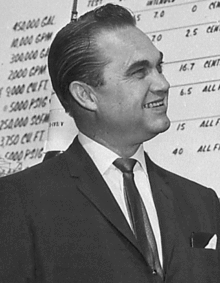 |
Governor of Alabama (1961–1967; 1971–1979) |
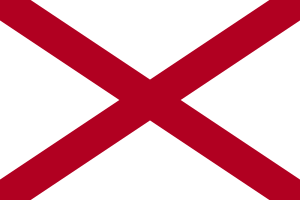 Alabama |
Announced campaign: January 13, 1972 |
3,755,424 (23.48%) |
5 FL, NC, MD, MI, TN | |
| Shirley Chisholm | 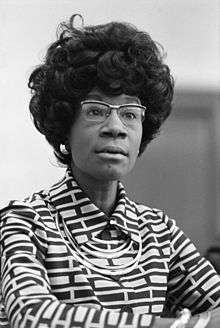 |
U.S. Representative from New York's 12th congressional district (1969–1983) |
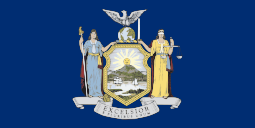 New York |
Announced campaign: January 25, 1972 |
430,703 (2.69%) |
1 NJ | |
| Terry Sanford | .jpg) |
Former Governor of North Carolina (1961–1965) |
.svg.png) North Carolina |
Announced campaign: March 8, 1972 |
331,415 (2.07%) |
None | |
| Sam Yorty | 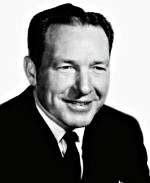 |
Mayor of Los Angeles, California (1961–1973) |
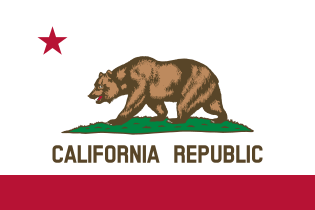 California |
 Announced campaign: January 13, 1972 |
79,446 (0.50%) |
None | |
| Wilbur Mills | 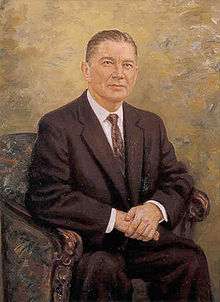 |
U.S. Representative for Arkansas's 2nd congressional district (1939–1977) |
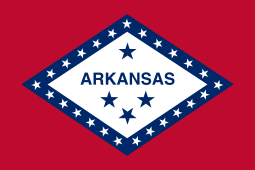 Arkansas |
Announced campaign: February 8, 1972 |
37,401 (0.23%) |
None | |
Withdrew during primaries
| Candidate | Most recent position | Home state | Campaign | Popular vote | Contests won | ||
|---|---|---|---|---|---|---|---|
| Edmund Muskie | .jpg) |
U.S. Senator from Maine (1959–1980) |
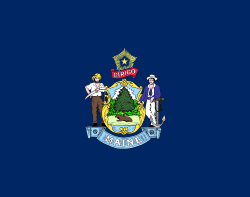 Maine |
Announced campaign: January 4, 1972 Withdrew: April 28, 1972 |
1,840,217 (11.51%) |
4 AZ, IL, IA, NH | |
| Eugene McCarthy | 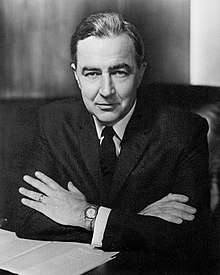 |
Former U.S. Senator from Minnesota (1959–1971) |
.svg.png) Minnesota |
Withdrew: May 22, 1972 (Endorsed McGovern) |
553,990 (3.46%) |
None | |
| Scoop Jackson | 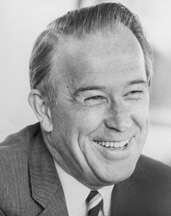 |
U.S. Senator from Washington (1953–1983) |
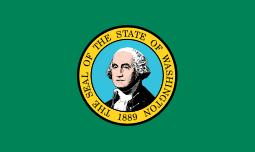 Washington |
Announced campaign: November 19, 1971 Withdrew: May 2, 1972 |
505,198 (3.16%) |
None | |
| John Lindsay | .jpg) |
Mayor of New York City (1966–1973) |
 New York |
 Withdrew: April 5, 1972 |
196,406 (1.23%) |
None | |
| Vance Hartke | 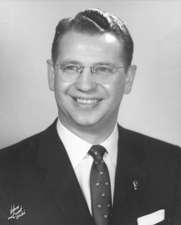 |
U.S. Senator from Indiana (1959–1977) |
 Indiana |
Withdrew: March 26, 1972 |
11,798 (0.07%) |
None | |
| Patsy Mink |  |
U.S. Representative from Hawaii (1965–1977) |
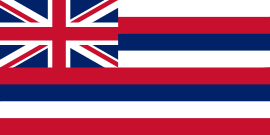 Hawaii |
Withdrew: May 24, 1972 | 8,286 (0.05%) |
None | |
Withdrew before primaries
| Candidate | Most recent position | Home state | Campaign | ||
|---|---|---|---|---|---|
| Fred Harris | 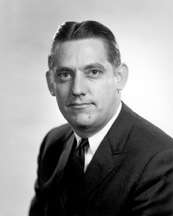 |
U.S. Senator from Oklahoma (1964–1973) |
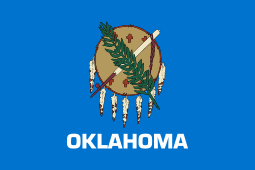 Oklahoma |
Announced campaign: September 24, 1971 Withdrew: November 10, 1971 | |
Favorite son
Additionally, Walter Fauntroy, Delegate to the United States House of Representatives from the District of Columbia, ran only in the District of Columbia primary for the purpose of controlling its delegate slate at the convention.
Polling
National polling
Before 1971
| Poll source | Publication | ||||||
|---|---|---|---|---|---|---|---|
| Gallup | Jan. 1969 | 21% | – | 45% | 7% | 1% | 17% |
| Gallup | Oct. 1969 | 29% | – | 27% | 10% | 5% | 24% |
| Gallup | May 1970 | 16% | 10% | 17% | 9% | 3% | 23% |
| Gallup | Nov. 1970 | 16% | 4% | 31% | 6% | 2% | 33% |
1971
| Poll source | Publication | |||||||
|---|---|---|---|---|---|---|---|---|
| Gallup | Feb. 1971 | 21% | 5% | – | 25% | 4% | 5% | 26% |
| Gallup | Apr. 1971 | 18% | 4% | 2% | 29% | 3% | 5% | 21% |
| Gallup | July 1971 | 18% | 3% | 1% | 22% | 6% | 5% | 22% |
| Gallup | Aug. 1971 | 13% | 6% | – | 26% | 4% | 6% | 22% |
| Gallup | Nov. 1971 | 19% | 4% | 6% | 29% | 5% | 6% | 24% |
| Gallup | Dec. 1971 | 19% | 4% | 4% | 32% | 4% | 5% | 25% |
1972
| Poll source | Publication | |||||||||
|---|---|---|---|---|---|---|---|---|---|---|
| Gallup | Jan. 1972 | 2% | 17% | 5% | 2% | 27% | 5% | 3% | 32% | – |
| Gallup | Feb. 1972 | 2% | 23% | 2% | 3% | 24% | 3% | 5% | 29% | – |
| Gallup | Mar. 1972 | 2% | 31% | 7% | 3% | – | 5% | 6% | 23% | 15% |
| Gallup | Mar. 1972 | 4% | 31% | 5% | 5% | – | 4% | 5% | 22% | 17% |
| Gallup | Apr. 1972 | 5% | 30% | – | 4% | – | 3% | 17% | 17% | 19% |
| Gallup | May 1972 | 3% | 35% | – | 3% | – | 3% | 20% | 11% | 18% |
| Gallup | May 1972 | – | 26% | – | – | – | – | 25% | – | 26% |
| Gallup | June 1972 | 3% | 27% | – | 3% | – | 2% | 30% | 6% | 25% |
Caucuses
The Iowa caucus was held first on January 24. Edmund Muskie won 35.5% support, George McGovern 22.6% and 35.8% of delegates were uncommitted.
11 states held caucuses before the 1972 convention in which one candidate captured a majority of support:
- January 29: Arizona - Edmund Muskie
- February 22: Minnesota - Hubert Humphrey
- March 7: Washington - Henry "Scoop" Jackson
- March 25: Maine - Edmund Muskie
- April 17: Idaho - George McGovern
- April 20: Vermont - George McGovern
- April 30: Nevada - George McGovern
- May 15: Colorado - George McGovern
- May 16: Utah - George McGovern
- June 18: Montana - George McGovern
- June 19: Arkansas - Wilbur Mills
Primaries
Statewide contests by winner
| Legend: | 1st place (popular vote) |
2nd place (popular vote) |
3rd place (popular vote) |
Candidate has withdrawn or ended active campaigning |
Candidate had not yet Joined |
|---|
| Hubert Humphrey |
George McGovern |
George Wallace |
Edmund Muskie |
Eugene McCarthy |
Scoop Jackson |
Shirley Chisholm |
Terry Sanford |
John Lindsay |
Sam Yorty |
Wilbur Mills |
Walter Fauntroy |
Vance Hartke |
Patsy Mink |
Unpledged | ||
|---|---|---|---|---|---|---|---|---|---|---|---|---|---|---|---|---|
| March 7 | New Hampshire (20 delegates) |
0.39% | 37.15% (6 delegates) |
0.20% | 46.41% (14 delegates) |
- | 0.22% | - | - | - | 6.08% | 4.01% | - | 2.72% | - | - |
| March 14 | Florida (81 delegates) |
18.56% (6 delegates) |
6.19% | 41.65% (75 delegates) |
8.90% | 0.46% | 13.46% | 3.48% | - | 6.52% | 0.20% | 0.36% | - | 0.24% | - | - |
| March 21 | Illinois (153 delegates) |
0.12% | 0.30% (13 delegates) |
0.57% | 62.60% (59 delegates) |
36.26% | 0.04% | 0.06% | - | 0.01% | - | - | - | - | - | - (88-Delegates) |
| April 4 | Wisconsin (67-Delegates) |
20.71% (13 delegates) |
29.55% (54 delegates) |
22.03% | 10.26% | 1.38% | 7.80% | 0.82% | - | 6.70% | 0.21% | 0.08% | - | 0.07% | 0.11% | 0.22% |
| April 25 | Massachusetts (102-Delegates) |
7.91% | 52.65% (102-Delegates) |
7.41% | 21.29% | 1.41% | 1.37% | 3.62% | - | 0.34% | 0.10% | 3.14% | - | 0.14% | - | - |
| April 25 | Pennsylvania (137-Delegates) |
35.05% (57-Delegates) |
20.43% (37-Delegates) |
21.27% (2-Delegates) |
20.36% (29-Delegates) |
- | 2.82% | 0.02% | - | - | - | - | - | - | - | - |
| May 2 | Washington, D.C. (15-Delegates) |
- | - | - | - | - | - | - | - | - | - | - | 71.78% (15-Delegates) |
- | - | 28.22% |
| May 2 | Indiana (76-Delegates) |
47.14% (55-Delegates) |
- | 41.19% (22-Delegates) |
11.67% | - | - | - | - | - | - | - | - | - | - | - |
| May 2 | Ohio (140-Delegates) |
41.28% (75-Delegates) |
39.70% (65-Delegates) |
- | 8.79% | 2.11% | 8.12% | - | - | - | - | - | - | - | - | - |
| May 4 | Tennessee (49-Delegates) |
15.90% | 7.22% | 68.16% (49-Delegates) |
1.96% | 0.46% | 1.20% | 3.82% | - | 0.30% | 0.14% | 0.52% | - | 0.33% | - | - |
| May 6 | North Carolina (64-Delegates) |
- | - | 50.34% (37-Delegates) |
3.74% | - | 1.15% | 7.51% | 37.26% (27-Delegates) |
- | - | - | - | - | - | - |
| May 9 | Nebraska (22-Delegates) |
34.33% (8-Delegates) |
41.28% (16-Delegates) |
12.45% | 3.58% | 1.66% | 2.75% | 0.92% | - | 0.65% | 1.80% | 0.20% | - | 0.13% | - | - |
| May 9 | West Virginia (35-Delegates) |
66.92% | - | 33.08% | - | - | - | - | - | - | - | - | - | - | - | - |
| May 16 | Maryland (53-Delegates) |
26.75% (?-Delegates) |
22.35% (?-Delegates) |
38.67% (41-Delegates) |
2.35% | 0.83% | 3.12% | 2.22% | - | 0.38% | 2.39% | 0.84% | - | - | 0.10% | - |
| May 16 | Michigan (132-Delegates) |
15.73% (25-Delegates) |
26.81% (36-Delegates) |
50.96% (71-Delegates) |
2.44% | - | 0.44% | 2.78% | - | - | - | - | - | - | - | 0.67% |
| May 23 | Oregon (34-Delegates) |
12.52% | 50.25% (34-Delegates) |
20.03% | 2.51% | 2.19% | 5.39% | 0.73% | - | 1.24% | - | 0.30% | - | - | 1.59% | - |
| May 23 | Rhode Island (22-Delegates) |
20.34% | 41.21% (22-Delegates) |
15.32% | 20.70% | 0.65% | 0.36% | - | - | - | 0.02% | 0.11% | - | - | - | 1.29% |
| June 6 | California (271-Delegates) |
38.58% | 43.50% (271-Delegates) |
7.53% | 2.04% | 0.96% | 0.81% | 4.42% | - | 0.74% | 1.42% | - | - | - | - | - |
| June 6 | New Jersey (0-Delegates) |
- | - | - | - | - | - | 66.94% | 33.06% | - | - | - | - | - | - | - |
| June 6 | New Mexico (18-Delegates) |
25.94% | 33.28% (10-Delegates) |
29.25% (8-Delegates) |
4.18% | - | 2.76% | 2.09% | - | - | - | - | - | - | - | 2.49% |
| June 6 | South Dakota (17-Delegates) |
- | 100% (17-Delegates) |
- | - | - | - | - | - | - | - | - | - | - | - | - |
| June 20 | New York (248-Delegates) |
- | ? (230-Delegates) |
- | ? (2-Delegates) |
- | - | ? (4-Delegates) |
- | - | - | - | - | - | - | ? (12-Delegates) |
Counties carried
 1972 Democratic primary results by county popular vote
|
Total primaries popular vote
Primaries popular vote results:[16]
- Hubert Humphrey - 4,121,372 (25.77%)
- George McGovern - 4,053,451 (25.34%)
- George Wallace - 3,755,424 (23.48%)
- Edmund Muskie - 1,840,217 (11.51%)
- Eugene McCarthy - 553,990 (3.46%)
- Henry M. Jackson - 505,198 (3.16%)
- Shirley Chisholm - 430,703 (2.69%)
- Terry Sanford - 331,415 (2.07%)
- John Lindsay - 196,406 (1.23%)
- Samuel Yorty - 79,446 (0.50%)
- Wilbur Mills - 37,401 (0.23%)
- Walter E. Fauntroy - 21,217 (0.13%)
- Vance Hartke - 11,798 (0.07%)
- Patsy Mink - 8,286 (0.05%)
Analysis
In the end, McGovern succeeded in winning the nomination by winning primaries through grass-roots support in spite of establishment opposition. He had led a commission to redesign the Democratic nomination system after the messy and confused nomination struggle and convention of 1968. The fundamental principle of the McGovern-Fraser Commission—that the Democratic primaries should determine the winner of the Democratic nomination—lasted throughout every subsequent nomination contest. However, the new rules angered many prominent Democrats whose influence was marginalized, and those politicians refused to support McGovern's campaign (some even supporting Nixon instead), leaving the McGovern campaign at a significant disadvantage in funding compared to Nixon.
See also
- Republican Party presidential primaries, 1972
References
- Frum, David (2000). How We Got Here: The '70s. New York, New York: Basic Books. p. 298. ISBN 0-465-04195-7.
- Freeman, Jo (February 2005). "Shirley Chisholm's 1972 Presidential Campaign". University of Illinois at Chicago Women's History Project. Archived from the original on 2015-01-26.
- Bernstein, Carl; Woodward, Bob (10 October 1972). "FBI Finds Nixon Aides Sabotaged Democrats". The Washington Post. Retrieved 24 Dec 2018.
- "Remembering Ed Muskie", Online NewsHour, PBS, March 26, 1996
- Pantazi, Andrew (2016). "Past Duval Presidential Elections". Jacksonville.com. The Florida Times-Union. Retrieved 25 December 2018.
Later that year segregationist George Wallace would be shot and handicapped, but before then, he won Florida’s primary decisively, carrying every county but Miami-Dade.
- "Article Says Nixon Schemed To Tie Foe to Wallace Attack". The New York Times. December 7, 1992. Retrieved March 1, 2020.
- "Nixon Plot to Tie McGovern to Wallace Attack Reported : Archives: Plan to plant campaign flyers is among new disclosures in unreleased tapes, magazine says". Los Angeles Times. December 7, 1992. Retrieved March 1, 2020.
- Salam, Reihan (May 27, 2003). "Double Scoop". The New Republic Online.
- "A Message of Discontent from Wisconsin Archived 2007-11-18 at the Wayback Machine", "AllPolitics", Time, 04-17-1972.
- https://www.washingtonpost.com/wp-srv/politics/daily/sept98/wallace051672.htm
- Miroff. pp. 205.
- Steinem, Gloria. Outrageous Acts. p. 114.
- The Editors of Encyclopedia Britannica. "United States presidential election of 1972". Britannica.com. Encyclopedia Britannica. Retrieved 3 August 2019.
- https://library.cqpress.com/cqalmanac/document.php?id=cqal72-1249975
- http://www.centerforpolitics.org/crystalball/articles/the-modern-history-of-the-democratic-presidential-primary-1972-2008/
- Our Campaigns - US President - D Primaries Race - Mar 07, 1972


